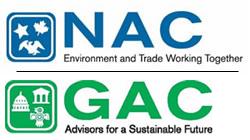National and Governmental Advisory Committees

The National Advisory Committee (NAC) and the Governmental Advisory Committee (GAC) advise the U.S. Representative (the Administrator of the U.S. Environmental Protection Agency) to the Commission for Environmental Cooperation (CEC) on the development of U.S. policy positions regarding implementation of the North American Agreement on Environmental Cooperation (NAAEC), now superseded by the Environmental Cooperation Agreement (ECA) and the United States-Mexico-Canada (USMCA) Free Trade Agreement. The NAC and GAC provide a valuable avenue for public input and help shape U.S. policies that improve the environment and health conditions of the United States, Canada, and Mexico.
About NAC and GAC
The NAC and GAC were created in 1994 and operate in accordance with the Federal Advisory Committee Act. Establishment of the committees is authorized under articles 17 and 18 of the North American Agreement on Environmental Cooperation (NAAEC) and by the North American Free Trade Agreement Implementation Act, P.L. 103-182, which authorizes U.S. participation in the CEC. Federal government responsibilities relating to the committees are set forth in Executive Order 12915, entitled “Federal Implementation of the North American Agreement on Environmental Cooperation.” The U.S. NAC and GAC produce advice letters on a periodic basis to fulfill their mandate.The NAC is composed of 15 members selected from environmental groups, business and academia, and the GAC is composed of 15 members from state, local, and Tribal governments.
NAAEC
Since 1994, Canada, Mexico and the United States have collaborated in protecting North America's environment through the NAAEC. The NAAEC seeks to build bridges among the three countries to promote environmental collaboration. The NAAEC is the first international agreement to link environmental cooperation with trade relations and the first to embed public engagement at the heart of its operations. The NAAEC establishes the CEC to facilitate effective cooperation on the conservation, protection, and enhancement of the North American environment.
The United States-Mexico-Canada (USMCA) Free Trade Agreement and Environmental Cooperation Agreement (ECA) entered into force on July 1, 2020, updating and replacing the North American Free Trade Agreement (NAFTA) and North American Agreement on Environmental Cooperation (NAAEC), in force since 1994.
CEC
The CEC is an international organization created by Canada, Mexico, and the United States under the NAAEC. The CEC was established to address regional environmental concerns, help prevent potential trade and environmental conflicts, and to promote the effective enforcement of environmental law. The Council reinforces the environmental provisions of NAFTA. For more information visit the CEC website at www.cec.org.
Accomplishments
The NAC and GAC produce letters of advice and reports on a periodic basis, and have been instrumental in advising the U.S. government on how to organize and lead the CEC. The committees contribute to the development of the CEC's Program Plan/Budget and its five-year Strategic Plan . The NAC and GAC also assist the U.S. in developing outcomes for the annual CEC Council meetings and serve as an integral partner in the tri-national efforts to further sustainable development in North America.
